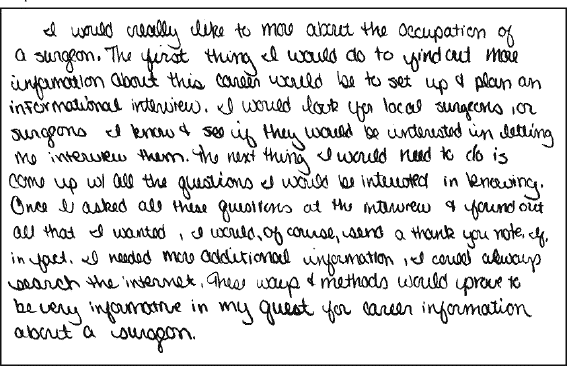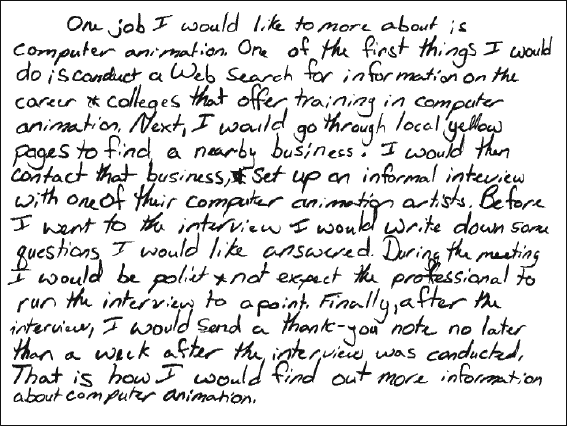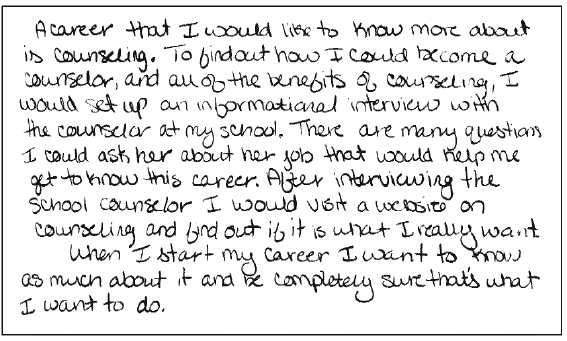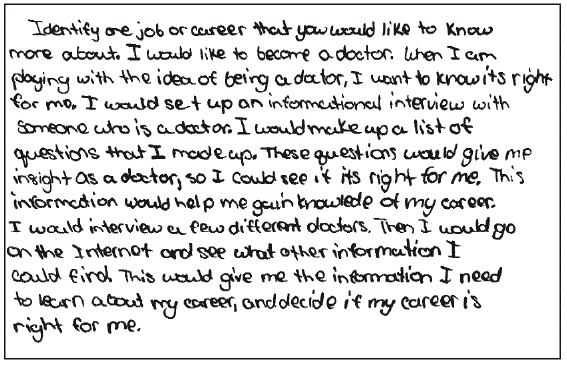The "Informational Interviewing: Choosing a
Career" Prompt
(Grade 10 reading, Montana)
Commentary by Timothy Horrigan; ex-Measured
Progress Test Reader; May 8, 2006)
This is a rather popular reading prompt, reused in many states. It even turns up (in a somewhat different form) as a writing prompt. I was inspired to use this as a sample question after putting up a page about a May 10-11, 2006 Job Fair at Measured Progress's Dover, NH scoring center.
This is the version of the question used on the Grade 10 Montana Comprehensive Assessment System (MontCAS) Criterion-Referenced Test (CRT). It was released to the public after the end of the 2003-2004 scoring season.
Click here to download the PDF file of this and another reading prompt, as issued by the Montana Office of Public Instruction.
Click here to see the Montana Office of Public Instruction's MontCAS website.
Like most high school reading prompts, this is a fairly boring article which a wide range of students will find equally irrelevant.
The article doesn't really address the actual ways a 10th Grader would go about actually learning about career possibilities.
The sample answers tend to stick to the script implied by the article: i.e., you do a brief summary of the article, plugging in a job title at the beginning and end of the essay. Even the sample 4 from a student who says he or she wants to be a "computer animator" sticks to the script: there's talk about finding companies which do computer animation in your area, interviewing an artist, etc. But there's something missing: there's nothing about actually doing animation yourself, even though most 10th graders are in a position to start doing simple animation right now using commonly available computers and video cameras. (And there are now a number of virtual worlds, e.g, the Second Life Teen Grid, where a kid can do some pretty advanced machinima at very low cost.) Reading rubrics do not encourage students to step outside the confines of the prompt to address the realities and fantasies of the larger universe: if anything, this type of thing is punished.
|
Informational Interviewing: Choosing a Career Have you ever wondered what working at a museum would be like? Are you considering a career in medicine? Or are you still unsure of the career options available to you? If you've answered yes to any of these questions, then consider a round of informational interviews with people whose jobs you're interested in learning more about. Informational interviews are job and career fact-finding missions. They are meetings you request with people whose work interests you. In many ways, an informational interview is the best kind of job interview, because you get to ask the questions. Theres no pressure to perform in the same way as in a traditional job interview. Another plus is that most working professionals welcome the opportunity to talk to others about what they do, so you'll find they're often quite willing to meet with you. All you need to do is ask. Here are some basic tips for requesting and conducting informational interviews. Use them as a guide. Let your interests and goals shape the specific questions you'd like answered. Make Contact
Prepare
|
||||
|
|
|
|||
Follow Up Within a week of your meeting, send a thank-you note to the person who interviewed you. If your contact offered to put you in touch with a colleague or provide supplemental information, mention that in your note and include a phone number or E-mail address where he or she can get in touch with you. It's always a good idea to touch on any memorable parts of your conversation— common interests, an amusing anecdote, or a good piece of advice. Doing so shows that you are engaged and serious about your research, as well as polished and sophisticated in your professional interactions.
|
||||
|
√ |
DO |
DON'T |
||
|
|
Be clear and direct |
Ask for a job |
||
|
|
Act professionally |
Limit your contacts |
||
|
|
Listen attentively |
Expect your contact to do all of the talking |
||
|
|
Ask questions |
Forget to send a thank-you note |
||
|
|
Analyze information |
|
||
|
|
Write a thank-you note |
|
||
|
For further information on informational interviewing, try the Internet Web links listed below. Each Web link is followed by a brief description of its contents and the Internet address where it can be found. Quintessential Careers: Informational Interviewing Tutorial Learn the "how-to" basics for one of the most important networking and job-hunting tools available to job-seekers: informational interviewing.
A helpful list of do's and don'ts for your informational interview.
Lists the benefits of informational interviewing.
A volunteer Informational Interviewing Network that provides employees with a resource to help make thoughtful and informed decisions. |
||||
Here's the actual question:
Identify one job or career that you would like to know more about. Use the information from this article to explain how you could find out as much information as possible about that job or career. |
The scoring rubric is as follows:
|
Score |
Description |
|
4 |
Response identifies one job or career and provides a fully developed explanation of how the information from the article could help someone find out as much information as possible about that job or career. |
|
3 |
Response identifies one job or career and provides an explanation of how the information from the article could help someone find out information about that job or career. The explanation lacks some specificity and/or development. |
|
2 |
Response identifies one job or career and provides a partial explanation of how the information from the article could help someone find information about the job or career. The explanation includes limited or partially correct information from the article. |
|
1 |
Response gives a minimal or vague statement about a job or career and how the information from the article could help in finding out information. |
|
0 |
Response is incorrect or irrelevant. |
|
Blank |
No response. |
Scoring Notes:
A fully developed response clearly identifies a job or career and references the three points of conducting an informational interview—Make Contact, Prepare, and Follow Up. The Follow Up should refer to a thank-you note and/or ways of finding further information about the job or career.
The rubric is designed to be rather subjective— and also rather flexible, which makes it easier to design prompts which get a nice symmetrical bell curve, centered close the middle of the range of possible scores (i.e., within the 2.0-2.5 range.)
The scoring notes are often cryptic: the "three points" mentioned above leave out the rather key step of actually conducting the interview. The three named activities would in reality never happen in linear sequential order: i..e., in real life you have to do some prep work before making contact, and you would make multiple contacts (with continuous preparation and follow up) with their person as your relationship with him or her progresses.
Finally, the third point "follow up" was treated as an afterthought. Oftentimes, these prompts end up testing the students' ability to distinguish the reality of the subject matter from the way the author presents it. In this case, the author artificially divides the process up into three sections with boldfaced headings on them, and that is the framework which the student is expected to view the process.
The phrase "Use the information from this article to explain..." seems like a throwaway to the average adult, but the students and the test developers both know what this means. It means you're supposed to read the article carefully, analyzing both the limitations of the author's worldview and the rhetorical devices used by the author. It also means you're supposed to frame your response using the same rhetorical devices and the same limitations, and moreover it means you're not supposed to think outside the article's box.
This prompt's article is not the most scintillating article these students have ever read, and their answers reflect this. The 2s though 4s are quite similar: the better answers are longer and refer (at least implicitly) to the three-part schema of " Make Contact, Prepare, and Follow Up." The students are not expected to go outside the limitations of the article: they don't have say anything specific about their chosen career. (In fact if they said too much about the actual career, while neglecting the informational interview, they would be marked down to 3 or 2.)
Score Point 4: Response identifies one job or career and provides a fully developed explanation of how the information from the article could help someone find out as much information as possible about that job or career.
These are both very good answers. They show that in the subject area of Reading (unlike Math) a 4 doesn't have to be perfect. And they certainly don't have to be brilliant. The first sample 4 is padded and repetitive, and it lacks much original insight. But it is error-free.
The second sample 4 is much livelier than the first one, and it is free of major mistakes. However, in addition to one or two minor trivial punctuation and spelling errors, it has one sentence which frankly makes no sense as written: "I would be polit[e] & not expect the professional to run the interview to a point." So, the professional would not be expected to run the interview to a point— a point of... what? What the heck does this mean? (Students can be marked down for nonsensical and/or incomprehensible statements. One of the biggest difficulties with scoring reading is figuring out what's bad but meaningful writing and what's just plain word salad. Spelling and grammar errors are not supposed to count towards a reading score, although in practice high-scoring answers tend to be literately written and low-scoring ones tend to be gibberish.)
1st Anchor 4:

2nd anchor 4:

Score Point 3: Response identifies one job or career and provides an explanation of how the information from the article could help someone find out information about that job or career. The explanation lacks some specificity and/or development.
These answers are significantly weaker than the 4s (albeit vastly superior to the 2s.) They also don't echo the rhetoric of the article: e.g., they don't divide the process up into the three steps of " Make Contact, Prepare, and Follow Up." The second one also gets marked down for going off topic a little by not sticking to interviewing just one professional a time when she says "I would interview a few different doctors."
Both the first and second ones both go off-topic when they talk about deciding whether a career is right for them and when they talk about looking for career information on the internet after the interview. The article clearly states that web searches are only relevant to the informational interviewing process during the "Make Contact" stage as a source of leads. Once you choose exactly one lead and make contact with him or her there is no need to go back to the web for any reason. During the interviewing process, all information flows from that one professional to the student. The stuff at the end about the web sites is a distractor: those sites are sources of information about informational interviewing qua informational interviewing, and not sources of information about career choices per se.
1st Anchor 3:

2nd Anchor 3:

Score Point 2: Response identifies one job or career and provides a partial explanation of how the information from the article could help someone find information about the job or career. The explanation includes limited or partially correct information from the article.
If a question and its rubric are designed correctly, 2 is the most common score point. Generally speaking, a 2 represents an answer which makes it halfway to the point of being a 3 or 4.
Depressingly, the sample 2's in this case are not very good at all. They represent the most common way of getting a 2: i.e., a fairly short, not very cogent essay which doesn't say anything which is blatantly incorrect. Quite often, as in this case, the 2s use the same rhetorical framework as a 3 or 4, but each element is much shorter: these students do name a profession and go through the three phases of the informational interview, but the phases are covered in a phrase or two each rather than in entire paragraphs.
Another way to get a 2 would be to produce a long, well-written essay which has a major misunderstanding (e.g., if the student were to emphasize that you should close the deal by asking for a job at the informational interview) and/or which goes off on a tangent which has nothing to do with the intended answer.
Although a large percentage of students get less than 2 points, it takes very little skill to produce a 2-level answer. If a student can stay on topic for even a couple of sentences, she has a very good chance of getting a 2.
1st Anchor 2:

2nd Anchor 2:

Score Point 1: Response gives a minimal or vague statement about a job or career and how the information from the article could help in finding out information.
Any markings which are directly related to the prompt get a 1. All you really need to do to get a 1 is to demonstrate that you looked at the article and were able to glean some idea of what it was about. You could probably just get a 1 for this question just by writing down the word "work."
There are no Anchor 0s provided for this prompt. They would be "intentional markings" which totally fail to answer the question. Such an intentional marking could be anything from an X to a drawing to a page or two of memorized rap lyrics — or just some plain old gibberish. As I said earlier, it is often hard to tell whether a given piece of gibberish is related to the prompt (and hence deserving of a 1 or perhaps even a 2) or whether it rates a Zero.
1st Anchor 1:

2nd Anchor 2:

For more information visit:

The
Forgotten Liars: the novel by Timothy Horrigan